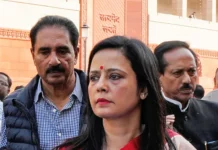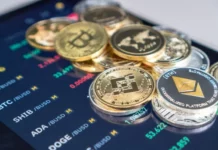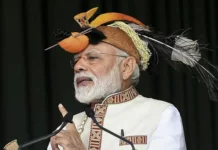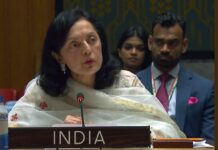LINA SHAH
This year in the spring break we made an adventure trip to Iceland. I would defiantly recommend visiting Iceland while glaciers still exist. Make sure to carry boots and rain jackets for Iceland’s unpredictable weather! While self-driving in Iceland, you will traverse between a mountain pass, over glacial rivers, and through stunning lava fields.
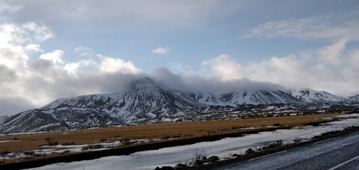 DAY 1
DAY 1
We arrived early morning at Keflavik airport and we started our day driving down the Iceland South Coast with the classic Golden Circle- Iceland’s most popular attractions, including Þingvellir National Park, the hot springs of the Haukadalur geothermal area, the majestic Gullfoss waterfall and the old implosion crater of Kerið. Þingvellir National Park – where the two tectonic plates separate Europe and North America. Þingvellir has been the site of many special moments in history. The Icelandic parliament, The Althingi, was established here around 930 AD and on June 17, 1944,, Icelanders celebrated their independence from Denmark in Þingvellir. It is a nice park to walk around in and see the plates divide. Usually, you need only 30 minutes to an hour here.
Next, we visited Strokkur Geyser – Haukadalur geothermal area, boiling mud pits, the smell of sulfur, and lively geysers at Geysir Hot Spring Area. We were amazed to capture the Geysers’ eruptions (every seven to 10 minutes). The next destination on the Iceland Golden Circle and one of the top attractions is a massive, stunning waterfall Gullfoss. It is an epic sight to behold. Unlike most waterfalls that you stand under, you actually stand above and gaze down into Gullfoss. The ‘Golden Waterfall’ is a breathtaking two-tiered waterfall that drops 32 meters into a narrow canyon 70 meters deep and 2.5 km long. Standing above the falls is a stone memorial to Sigríður Tómasdóttir, who, a number of years ago, threatened to throw herself into the falls in protest against foreign investors who wanted to buy the waterfalls and use them as a power supply. The government eventually intervened, bought the falls and made them the property of the Icelandic nation. We tried finding another hidden treasure of Bruarfoss Waterfall, however, due to weather conditions some roads were closed and it needed a hike of about 3.5 km and we missed that point.
Next was Kerið crater lake -the old implosion crater of Kerið. The 55-meter-deep crater is 3,000 years old, and is part of the larger Tjarnarhólar area, a collection of crater-hills. The story goes that when the water level rises in Kerið, it falls an equal amount in the small lake on the mountain Búrfell in the Grímsnes district, and vice versa. It’s like some mystical seesaw!The next destination was a relaxing one – a secret lagoon and natural hot springs located in a small village called Fludir. The pool’s natural surroundings and steam rising into the air gives the place a magical feeling. Our night stay was in Selfoss, a small town.
DAY 2 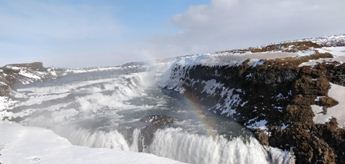
They say if you don’t like weather in Iceland, just wait for five minutes. It’s very true. Today we amazingly experienced changing weather from bright sunny to cloudy, rainy, hail storm and windy. Our first stop was Lava Center (lavacenter.is), a very impressive exhibition of Iceland’s volcanic activity, located on Ring Road at Hvolsvollur. It’s a must to experience magma chamber, an earthquake simulator and volcano erupt on interactive screens. Gives great understanding of the power of Iceland’s nature and its sleeping giants.
The next fascinating stop was Seljalandsfoss Waterfall- both our kids walked behind! Although beautiful, kids much prefer the hidden Gljúfrabúi Waterfall in all of its glory! Its about a quarter of a mile walk to the left. On our way along the south coast we drove past the popular bra fence next to the Cave Steinahellir. Our next stop was Skogar museum – a home of cultural heritage boasting an array of interesting artefacts, including an original turf farm that shows how people lived hundreds of years ago (skogasafn.is).
From here, it’s a walking distance to the stunning Skogafoss Waterfall- a magnificent 60-meter-high waterfall where, according to legend, the first Viking settler in the area hid a treasure in the cave behind the cascade. If you thought the first two waterfalls were epic, you are in for a real treat! It was a great spot for a rainbow picture. This stop is a must as it is one of the most iconic spots in the country.
Then, we went on an exciting hike of about 1.5 km from route 1 to see a Sólheimajökull, one of the most easily accessible glaciers of the mighty icecap of Mýrdalsjökull on the South Coast of Iceland. The nearby Eyjafjallajökull erupted in 2010 causing widespread havoc at European airports. With severe weather conditions, we could not go to Sólheimasandur Airplane Wreck, where the abandoned US plane is located and ended our day driving back to Selfoss. That night, we enjoyed great vegan food on main street in Selfoss at KaffiKrus – very co-operative and friendly environment with variety of vegan dishes (kaffikrus.is).
DAY 3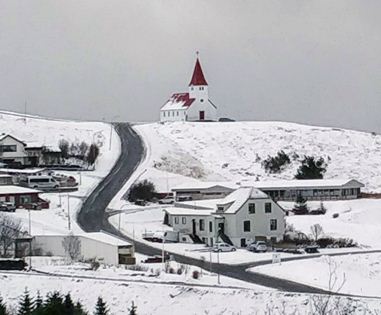
Our first stop was Dyrhólaey, a 120-meter-high promontory jutting out into the Atlantic Ocean, looming over the Reynisfjara black volcanic beach. It’s a spectacular sight and the century-old lighthouse is one to behold with its natural arch and prominent hole, sculpted over millennia from the force of the waves. Owing to its unique shape, its Icelandic name translates to “door hill island”. Next stop was Vik, a town famous for its natural beauty and mild climate with approximately 300 inhabitants. It has been an official trading post since 1887. We visited the Skaftfellingur Museum, a nearly 100-year-old oak ship on display, along with the ship’s equipment. There are tales about a number of marine accidents that occurred off the South Coast of Iceland, and a video from the 1950s about the Skaftfellingur ship. It was lunch time and we enjoyed one of the best soups at a local family-owned soup company, located in the heart of Vik (thesoupcompanyiceland.com). We simply loved the delicious vegetarian soup with freshly baked bread on a cold rainy day. The special light blue color of soup was created from burnt wood ashes. In the same building. We also had the unique experience of red-hot lava at newly started Icelandic Lava Show, recreating volcano eruption by pouring molten lava into a room full of people (icelandiclavashow.com).
From here, we started driving to Skaftafell National Park, part of Iceland’s largest national park Vatnajokullat. Covering 5,000 sq km, it is a place of immense natural beauty with a variety of landscapes, icebergs, canyons, hanging valleys, ice tunnels and arches, glacial rivers, and much more. Going through an off-road on gravels and passing over potholes for about two km was worth it as we took in a wonderful glacier lagoon very close. We stopped over at the spectacular Diamond beach near Jökulsárlón right next to the glacier lagoon, where chunks of ice washed ashore and wee scattered like huge diamonds glistening against the stark black sands. That night, at Hofn, we were lucky enough to see the Northern Lights. It was amazing to chase the light in nighttime and see those dancing green color.
DAY 4
We started the morning admiring black sand and a Viking village. In the afternoon, we checked out glaciers and lava fields, and in the evening, we drove to the city of Hofn and enjoyed the harbor. By driving down a small gravel road twisting away from the main route from Höfn to Djúpivogur, we found a Viking village in the Vestrahorn mountain. A film set for an Icelandic movie that was never filmed was nice to explore on how Vikings lived. We walked on the black sand beach nearby and also went to the observation gallery. Farmers’ horses grazed nearby on the fields beneath the shadow of the mountain, adding extra authenticity to the surroundings.
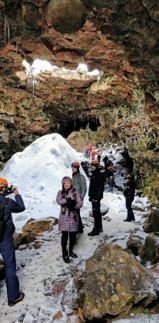
In the afternoon, we put on crampons and helmets and took an adventure tour of Glacier Walk and ice cave exploration with Ice Explorers of Vatnajokull (explorers.is). Tour The guide was very humoros taking us through a gravel road and glaciers in a jeep. We loved the glacier hike and spectacular ice cave walk. On returning, once again we spent some time on Diamond beach for photography near Jokulsarlon. The rest of the time we spent at Jokulsarlon Glacier Ice Lagoon where blockbusters like Tomb Raider, Batman Begins, ShahRuk Khan’s Dilwalee and two James Bond films – A View to a Kill and Die Another Day – were filmed. It’s not surprising why famous directors choose this amazing location as a backdrop! This extremely picturesque glacial lagoon on the southern edge of the Vatnajökull glacier is regarded as one of Iceland’s greatest natural wonders. Huge chunks of ice regularly calve off the glacier and make their way to the sea via the glacier lagoon. From land we also spot playful seals swimming in the chilly waters. We could not do the Amphibian Boat Tour as it closes at 5 p.m. That evening we had a very delicious dinner at Ish u sid pizzeria (ishusidpizzeria.is) at the Hofn harbor area.
DAY 5
On our way back to Reykjavik we visited Reynisfjara, the most famous beach in Iceland with its black volcanic sands, smooth pebbles, and unique rock formations. From the beach took in a view of the Reynisdrangar sea stacks. These bizarre looking rock pillars are basalt columns that were once part of the extensive shoreline cliffs that remained standing while other parts were battered down by the ocean. We climbing on these for unforgettable photos! Watch for deadly “sneaker waves” here in Reynisfjara.
The rest of the day we spent in downtown of Reykjavik, exploring Saga Museum, Arora Reykjavik, Sun Voyager, a famous statue, and walking around waterfront Perlan, one of the great landmarks in Reykjavik, and Old Harbor and enjoyed the famous ice-cream of Valdis. Saga Museum is jam-packed with information about the Viking settlers, and it uses life-like replicas of Icelandic historical figures to recreate key moments in Iceland’s history. We enjoyed dressing up as Vikings and taking pictures at Saga museum. The iconic Perlan building towers over the city from the top of a hill in the Öskjuhlíð area. The hemispherical structure builds on top of a six aluminum-sided tanks, each of which can contain four million liters of water averaging 85°C (185°F), provides an unmatched, panoramic view of the capital area from its observation decks. The kids enjoyed immersing through several exhibits of wild Icelandic nature, ice caves and Arora Northern Lights planetarium. We dined at the famous VOX restaurant of Hilton Nordica.
DAY 6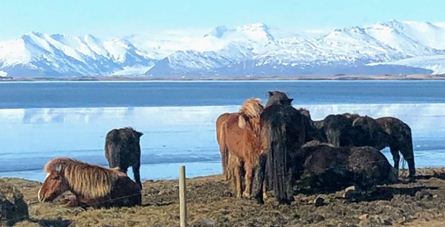
We visited the famous Lava Tunnel (thelavatunnel.is), just 30 minutes from downtown Reykjavik, created by a mighty power of a volcanic eruption that took place over 5000 years ago. We learned about the dynamics of volcanic eruptions and their effect on the surroundings. Huge ice sculptures and icicles filled up the interior where three big holes formed as cave collapsed. Our next stop was at a geothermal exhibition “ON” in a power plant (geothermalexhibition.com) where we explored the utilization of geothermal energy for heated water, earthquake sound simulator, the turbines at work and mineral collection. Next, we rode on Icelandic horses and discovered a unique volcanic landscape. Due to sudden changes in weather, we ended up spending time in learning about Icelandic horses at Eldhestar (eldhestar.is). The Icelandic horse arrived here on the Viking ships of the settlers over a thousand years ago and adapted to the harsh environment, resulting in a special breed unique to this country. We learned about this amazing animal, its unique ‘tölt’ gait, small stature, and spirited but friendly temperament. Eldhestar has about 350 horses and also holds horse shows. We were able to ride the horses indoor and experienced the tolt gait and watched changing the horse shoe.
The rest of the day we spent shopping on Laugavegur Street, visiting Hallgrimskirkja , an iconic church, Volcano House (volcanohouse.is) and dining at Gandhi restaurant for Indian food.
DAY 7
We kept the day for relaxing at Blue lagoon. We booked in advance for a deluxe package and enjoyed four hours with warm geothermal natural spring water with face mud pack and a drink before departing



